This particular variant, the M10x40 with a class of A2-70-L2A, defines a specific size, material composition, and mechanical properties. The M10x40 refers to a bolt with a diameter of 10mm and a length of 40mm. The “A2-70” indicates that the bolt is made of stainless steel with moderate corrosion resistance and a tensile strength of in 938 – m10x40 – a2-70-l2a classification represents a further level of specification for the surface treatment, making it ideal for certain environmental conditions.
2. Understanding the Dimensions: M10x40
The first part of the classification—in 938 – m10x40 – a2-70-l2a—indicates that the bolt has a nominal diameter of 10mm, a critical measurement when selecting bolts for specific applications. The number “10” refers to the diameter, and the “M” indicates that it is a metric thread. The “40” indicates the length of the bolt, measured in millimeters. These dimensions are essential for ensuring compatibility with nuts and threaded holes in various machinery and structural components.
3. Material Specifications: A2-70 Stainless Steel
The “A2” in the designation stands for stainless steel with a low carbon content, often referred to as 304 stainless steel. This material is widely recognized for its excellent resistance to corrosion and rust, making it ideal for applications where environmental factors may affect the longevity and performance of the fastener.
4. L2A Surface Treatment: Enhanced Protection

The L2A classification signifies a specific surface treatment applied to the bolt, providing additional protection against corrosion. especially in harsh environments.
5. Applications of DIN 938 – M10x40 – A2-70-L2A Bolts
The versatility of these bolts makes them ideal for both heavy-duty applications and those requiring high corrosion resistance. Their precise dimensions ensure a secure fit in machinery and equipment, reducing the risk of failure in crucial systems.
6. Importance of Adhering to DIN Standards
Adhering to these standards ensures that components like the M10x40 A2-70-L2A bolts meet strict criteria for strength, material composition, and performance. This standardization is vital for engineers, manufacturers, and maintenance professionals, as it simplifies the process of selecting and verifying components. It reduces the risks of incompatibility and failures due to substandard or incorrectly specified parts.

